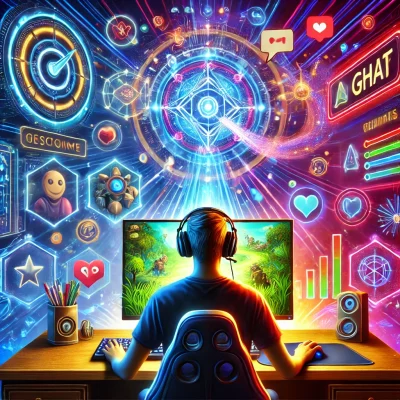Online gaming has taken the world by storm, pulling in millions of players from all walks of life. From simple mobile games to deep MMORPGs, the charm of online gaming is clear. But what makes these games so hard to put down? The secret lies in the psychology of gaming and the smart design tricks that keep players engaged.
1. The Dopamine Effect: Rewards and Pleasure
Gaming addiction often starts with the brain’s reward system. Online games are crafted to release dopamine, a neurotransmitter linked to pleasure and motivation. Each time a player hits a goal—leveling up, finishing a quest, or winning a match—they get a dopamine rush.
Key Features That Trigger Dopamine:
- Achievements and Badges: Unlocking these gives players a sense of achievement.
- Loot Boxes and Rewards: Random rewards create excitement, similar to gambling.
- Progression Systems: Progress bars and experience points show advancement.
This loop of rewards keeps players coming back for more.
2. The Power of Social Interaction
Humans are social by nature, and online games use this to their advantage by building a sense of community and competition. Many games include chat systems, guilds, or clans, letting players connect worldwide. These interactions foster a sense of belonging.
Social Elements That Enhance Engagement:
- Teamwork: Cooperative gameplay, like raids or team matches, builds camaraderie.
- Competition: Leaderboards and rankings appeal to competitive instincts.
- Friendship and Identity: Players often make deep friendships or even romantic connections within gaming communities.
These social ties make it tough to leave the game, as players feel connected to their in-game friends and roles.
3. Escapism: A Break from Reality
Online gaming offers a break from the daily grind. In these virtual worlds, players can take on new roles, find success, and explore amazing settings. This chance to escape is especially tempting during tough times, like a stressful job or personal struggles.
Why Escapism Works in Gaming:
- Role-Playing: Games let players become heroes or adventurers, far from their real lives.
- Control and Mastery: Players have control over game outcomes, providing a sense of agency often missing in real life.
- Immersive Worlds: Detailed graphics and stories create environments where players can fully lose themselves.
4. The Role of Competition and Mastery
Another big driver is the urge to improve and compete. Games give players clear goals and ways to track progress, like climbing ranks or mastering game mechanics. This sense of getting better fuels motivation and keeps players hooked.
Examples of Mastery in Gaming:
- Skill Development: Games need strategic thinking, quick reflexes, or problem-solving.
- Challenge: Increasing difficulty levels push players to improve.
- Recognition: High scores or rare items give social validation among peers.
5. Fear of Missing Out (FOMO)
Game developers use limited-time events, exclusive rewards, and daily bonuses to create urgency. Players worry about missing rare chances or falling behind, driving them to stay engaged.
Common FOMO Tactics:
- Limited-Time Events: Seasonal challenges with unique rewards.
- Daily Rewards: Bonuses for logging in every day.
- Exclusive Content: Rare items or characters available for a short time.
These tactics play on the fear of missing out, keeping players coming back. These strategies keep participants engaged with the game, ensuring they frequently return to play.
6. The Importance of Game Design: Simple to Start, Difficult to Leave
The design of a game greatly influences why we become attached. Today’s online games are crafted to be easy for newcomers yet challenging enough for experienced players. This balance of difficulty and reward keeps players interested without overwhelming them.
Key Design Elements:
Onboarding: Tutorials and initial rewards make it simple for new players to begin. Variable Rewards: Unpredictable rewards, such as loot drops, maintain curiosity and engagement. Endless Content: Open-world games and continuous updates ensure there’s always something new to discover.
7. The Negative Aspect: Gaming Addiction
Although gaming can be a healthy pastime, the psychological hooks that make it enjoyable can also result in addiction. Overindulging in gaming can disrupt daily responsibilities, relationships, and mental health.
Symptoms of Gaming Addiction:
- Ignoring personal or professional duties.
- Feeling irritable or anxious when not playing.
- Relying on gaming to manage stress or negative emotions.
Fortunately, awareness of gaming addiction has increased, and many developers now provide tools like playtime trackers and parental controls to help regulate gaming habits.
Conclusion: Balancing Enjoyment and Responsibility
Online gaming attracts players by blending rewards, social interaction, and immersive experiences. Recognizing the psychology behind our engagement can help players make better choices about their gaming behavior. While gaming can bring happiness, community, and even skill enhancement, moderation is essential to ensure it remains a positive aspect of life.
As the gaming world continues to progress, maintaining a healthy balance between entertainment and responsibility will become increasingly crucial. Ultimately, the primary aim of gaming should be fun—not captivity.

Leave a Reply